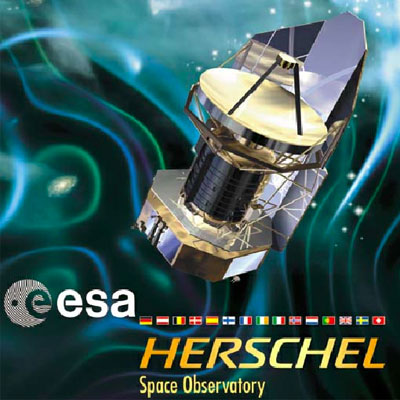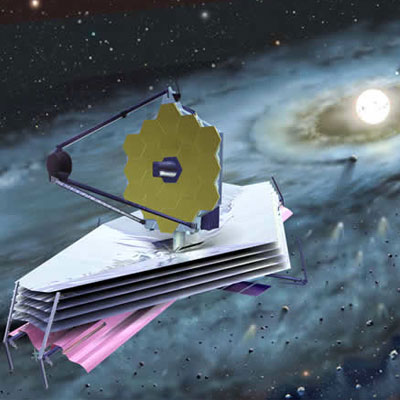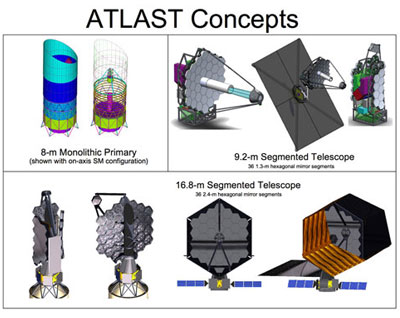 This week, Science Friday celebrates the 20th birthday of America’s favorite space telescope: The Hubble! On April 24th, 1990, the HST launched aboard Space Shuttle Discovery on mission STS-31. Since then, it (along with the help of many scientists) has taken some of the most beautiful and detailed images of the universe ever. Today, we commemorate the Hubble’s 20th year in space with a look at its history and accomplishments.
This week, Science Friday celebrates the 20th birthday of America’s favorite space telescope: The Hubble! On April 24th, 1990, the HST launched aboard Space Shuttle Discovery on mission STS-31. Since then, it (along with the help of many scientists) has taken some of the most beautiful and detailed images of the universe ever. Today, we commemorate the Hubble’s 20th year in space with a look at its history and accomplishments.
Liftoff of Space Shuttle Discovery with the Hubble Space Telescope!
On April 24th, 1990, Space Shuttle Discovery launched into space carrying the Hubble Space Telescope. The HST was deployed into orbit the next day. Although Hubble is now a household name, when it was first proposed, it was an instrument that much of the astronomical community didn’t want. It was very expensive, and many didn’t see the potential for great scientific return. These days, the Hubble is in great demand. An astronomer usually faces competition from at least 11 other eager scientists when submitting a proposal to point the telescope at some interesting region of space. Watch the video below of the launch of HST into space.
The Humble History of Hubble
Earth based telescopes date back to the days of Galileo in the 1600’s, and they have been advancing in complexity ever since. But, even the most modern ground-based telescopes have to deal with a major disadvantage: looking through the Earth’s atmosphere. The idea of a space-based telescope, that would theoretically obtain much sharper images, was first proposed by Lyman Spitzer in the 1940s, although the Hubble didn’t begin to take shape until a proposal for a space telescope was made in 1962 by the National Academies of Science.
In 1970, NASA finally began pondering the feasibility of such an instrument, and this led Bob O’Dell, now at Vanderbilt University in Tennessee, to take a risk. In 1971 he left his job at the University of Chicago to become the Hubble’s first project scientist. “I gave up a tenured professorship. I resigned from that to gamble on a project that wasn’t even funded,” O’Dell tells NatureNews. He spent the next 12 years trying to sell the idea to NASA funders and to his peers, many
of whom would have rather seen NASA pay for 20 ground-based telescopes and didn’t think that the advantage of being above the atmosphere was worth the trouble, he says.
Through O’Dell’s efforts the Independent Space Telescope Science Institute was established in 1983, and Hubble’s launch was slated for 1986. Because of the Challenger shuttle disaster, it was delayed until 1990 when it was finally launched into it’s orbit 575 kilometers above the earth in 1990.
Interview with Dr. Ed Weller
From a Rocky Start to an Iconic Spacecraft
Even after it was launched, Hubble was not without its problems. When the first images returned from Hubble, scientists realized one major flaw – the mirror was the wrong shape at the edges, which made the first images blurry. O’Dell insists that the pictures were still better than contemporary ground-based observations, but because of the blurriness, only the mid 20% of a Hubble image was tightly focused. Luckily, the telescope was designed to be constantly serviced, with no limit fixed to its ultimate life span. After the first servicing missing in 1993, the optics were upgraded and pictures came into sharper focus. Since then, Hubble has undergone four major services, the most recent taking place in May of last year. “The Hubble of today is not the Hubble that launched,” says astronomer Sandra Faber to Nature. She calculates that today the instrument is 60 times more powerful than in 1990.
In 2003, the future of the Hubble became uncertain. Many did not think it would survive NASA’s budget cuts. The final servicing mission was scheduled to take place in 2004, but was cancelled by then-NASA administrator Sean O’Keefe. His successor Mike Griffin reinstated the mission in 2006. Now that Hubble is 20, its future has been assured until the end of April 2013. After that, no servicing missions have been planned. If left to itself, the Hubble’s solar panels and batteries will begin to fail until we can no longer communicate with it. But, even if its mission does end there, Hubble’s work will be carried out by her successors, such as the James Webb Space Telescope, set to launch in 2014.
What’s Next: Hubble Successors
Long after Hubble is gone, humans will still have unending questions about the nature of our universe. We’re going to need another space telescope! Luckily for us, there are others out there and more on the way. The ESA’s Herschel space telescope was launched on May 14th, 2009. With at 3.5 meter Cassegrain telescope, it is currently the largest space telescope ever launched. Herschel has already begun making incredible new discoveries. See some of its “first light” images at the official website.

Next on the list is the future James Webb Space Telescope, scheduled for launch in 2014. JWST will look for the first galaxies that formed in the early Universe, connecting the Big Bang to our own Milky Way Galaxy. JWST is designed to work primarily in the infrared range, with some capability in the visible as well. If you think Herschel is big, the James Webb mirror will be 6.5 meters in diameter and will reside in an orbit about 1.5 million kilometers from the Earth.

James Webb Space Telescope
Even farther into the future is the ASTLAST, or Advanced Technology Large Aperture Space Telescope, a NASA strategic mission concept study for the next generation of space observation. ATLAST will have a primary mirror diameter on the order of 8m to 16m, allowing scientists to perform some of the most challenging observations to date in order to answer some of our most compelling astrophysical questions. The ATLAST is currently in the prototype phase, and has some initial concept designs.

ATLAST
Of course, there are tons of other great space telescopes out there these days. Check out all of NASA’s current missions at the NASA missions website.
Video of the Week: First Light from the Solar Dynamics Observatory
The Solar Dynamics Observatory (SDO) has been called “Hubble for the Sun.” Researchers recently released the First Light images from SDO with some incredible videos of huge erupting prominences, crackling solar flares, and gigantic shock waves shown with clarity ten times better than HDTV. See the video below, and check out NASA’s website for full-res videos and images. A MUST SEE!
More on Hubble
Not enough Hubble for you? Here’s a warp-speed look at some more space telescope links.
- Space.com: 20 Years of Cosmic Awa & Best Hubble Images of All Time
-
NASA: 20 Years of Hubble
-
UniverseToday: Hubble’s Late Teen Years
-
Official sites: hubble.nasa.gov & hubblesite.org
More Science Quickies
Hubble isn’t the only thing going on in science this week. Here’s a warp-speed look at some more science tid-bits that are worth a look.
- US military launches top-secret robotic spacecraft
TrekMovie’s Science Friday is an homage the the great NPR radio show Science Friday. Science Friday® is a registered service mark of ScienceFriday Inc.

“Hubble for the Sun” : AWESOME!!! =O
Shatners voice in echo: “Space… Totally Cool!”
I wanna see Voyager fly through that solar flare loop.
Thanks, Kayla!
We need the rest of the timeline, all the way to the Argus Array!
(Also – Thanks, Kayla.)
So… I wonder how much the Russians are going to charge us for launching the Webb ;)
Many thanks for bringing us great pictures, Hubble!
Incredible beauty!
I love space!
I wonder what we’ll see next.
shum te bukura jeni fantastyik
Happy birthday Hubble! Here’s an article that features Hubble images that were seen on Star Trek:
http://www.ex-astris-scientia.org/database/nasa_references.htm#voy
So we’re retiring the shuttle in time for the Military to start launching secret missions on their own smaller drone version, eh?
Awesome…